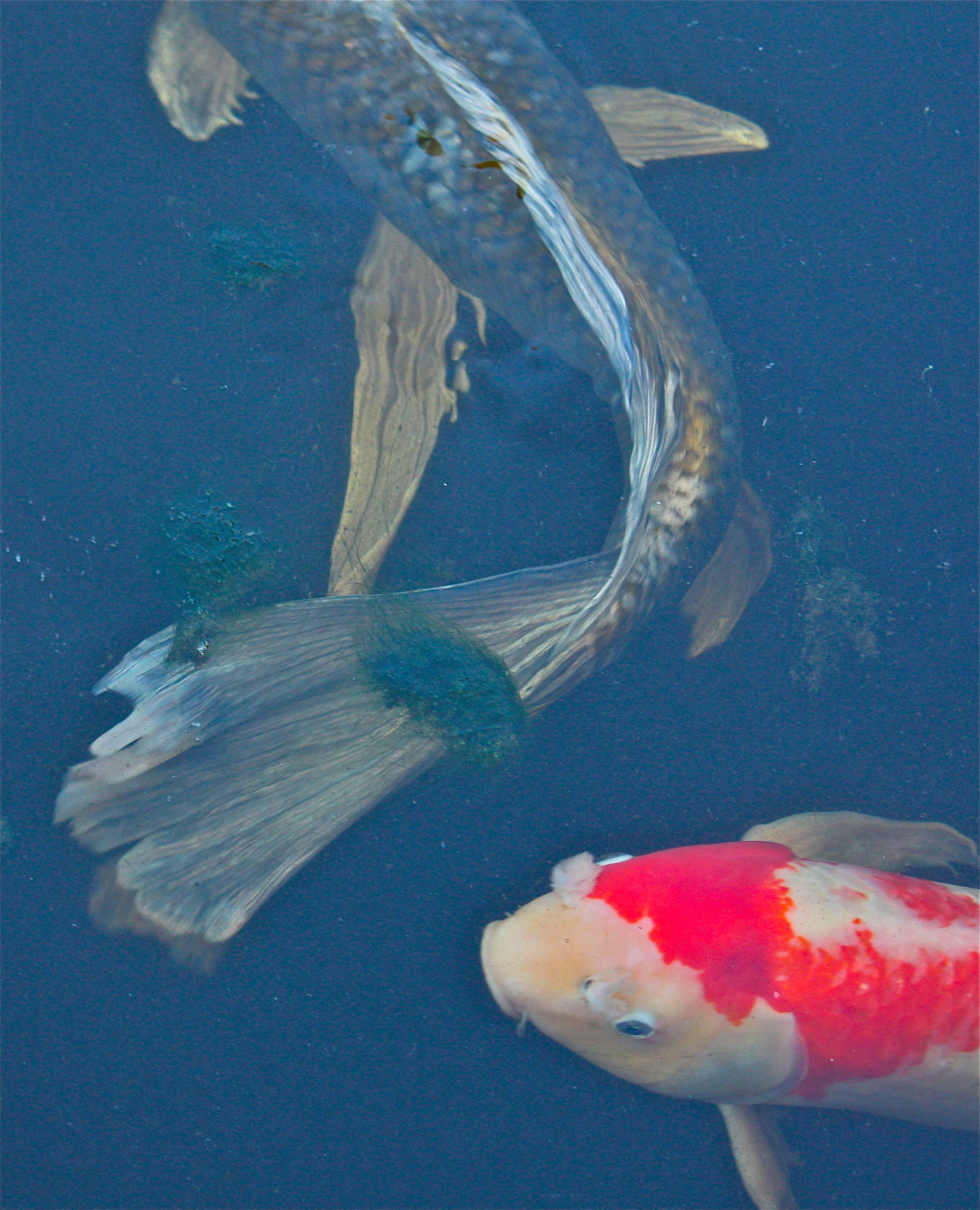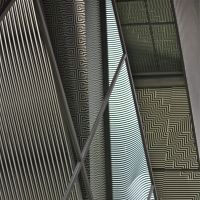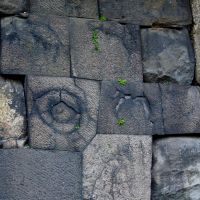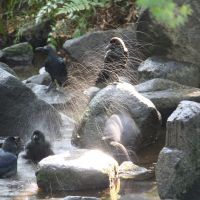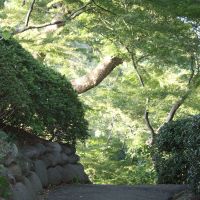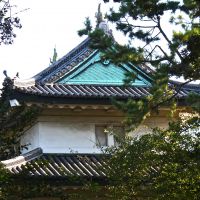With November drawing to a close, I head to the East Garden of the Imperial Palace and the adjacent Kitanomaru Koen park, hoping for fall colors and a mental breather before the season goes nutcrackers with parties and shopping.
Despite being at the city's epicenter, both these Chiyoda Ward locales remain as mysterious as backstreets to many Tokyoites. Not so the 5-km course circuiting the palace grounds, however, where I must dodge a stampede of earnest joggers to get to the massive wooden portals of the Imperial Palace's Otemon Gate.
An entrance to Edo Castle during the 250-odd years that Edo (present-day Tokyo) was the Tokugawa Shogunate's political capital, and then to the Imperial family residence following the 1868 Meiji Restoration, Otemon today is open to all except on Mondays, Fridays and occasional holidays. The gardens were made public in 1968.
Though its design dates back to the Edo Period (1603-1867), and it is roofed in the koraimon (Korean) style, the Otemon Gate has often been rebuilt due to earthquakes and fires — and World War II bombing. So, while the current portal may appear ancient, it has actually only been there since 1967.
A congenial guard points out chunks missing from the usually pristine, stuccoed walls. "Those fell during the March 11 earthquake this year," he says, without batting an eye. Castle upkeep, I realize, must be an ongoing project.
Just inside the Otemon Gate, I find not a garden but a tightly enclosed square, called a masugata, that was designed to box in enemies who had breached the first gate's defences by presenting them with an adjacent gate set at an inconvenient angle. That second, watari-yaguramon gate, featured turrets filled with weapons, from where the trapped attackers would be picked off by guards stationed there and all around the walls.
Rather than get claustrophobic, I think outside the box and focus instead on how the maze of walls creates a hushed atmosphere remote from traffic in the business district of Otemachi (literally, "town in front of Otemon") mere yards away.
Toodling uphill, I find the Sannomaru Shozokan, a museum preserving approximately 9,500 paintings, crafts and documents donated by the Imperial family. Just outside the museum, I find Japanese tourists snapping photos of blossoms on a jyugatsu-zakura, an October-blooming cherry tree. Unusual warmth this year seems to have coaxed it into a late show. Since the weather really is bloomin' warm, I save the museum for a less pleasant day.
Continuing up the slope, my progress is arrested by three solemn wooden guardhouses: the Doshin-bansho, or initial checkpoint station; the Hyakunin-bansho, which housed rotations of 100 armed guardsmen; and the O-bansho, or large guardhouse, which protected Edo Castle's Honmaru, or inner palace enceinte.
While sporting roof-tile renovations and some structural restoration, these three guardhouses look much as they must have during the feudal Edo Period — though decidedly less intimidating today against the backdrop of Otemachi's skyscrapers.
The surrounding castle walls, however-built of massive stones cut and layered in the nearly seamless and often watertight kirikomi-hagi style — are awe-inspiring. Though designed for protection, this masonry quarried from the Izu Peninsula in present-day Shizuoka Prefecture also rocks an aesthetic as appealing as giant Cubist paintings in gray and sepia.
As I continue further uphill, sunbeams glint off pine needles and my boots crunch the pavement leading to the Chujakumon Gate. The cut rocks here look tortured and flaked, resembling burnt flower petals. A fierce fire in 1863 that razed the central enceinte is said to have left these scars on them.
Now at the Honmaru plateau, where the shogun's residence was in Edo Castle, I veer down an inviting path to the left. When it gets dark and spidery, I fear I've wandered astray. Instead, the path dead-ends at the impressive Fujimiyagura, a three-story turret so named because back in the day it was possible to see 100-km-distant Mount Fuji from there. The turret was burned in Edo's Meireki fire (1657), rebuilt in 1659, then leveled in the Great Kanto Earthquake (1923), only to be rebuilt from the same materials in 1925. I can't help but imagine the castle breakfast talk: "Honey, the southwest turret's down again. Can you fix it?" Luckily, the keep seems to have escaped harm this year.
Next, I stumble upon a small stone monument marking the infamous Matsu-no-Oroka (Pine Corridor) where, in 1701, Lord Asano Takumi-no-Kami Naganori responded to an insult from Lord Kira Kozuke-no-Suke Yoshihisa by drawing his short sword and slashing the high-placed official.
Kira was not seriously injured, but unsheathing a sword in the castle was a serious offense. Asano was ordered to commit seppuku (ritual suicide), and his lands were confiscated. His 47 retainers, now ronin (masterless samurai), plotted revenge for more than a year, then broke into Kira's residence, beheaded him, and placed the gruesome trophy on Asano's grave at Sengakuji Temple near today's Shinagawa Station. Knowing their actions would not be forgiven, all 47 ronin committed ritual suicide. Their tragic sense of honor, fictionalized in plays, movies and poems titled "Chūshingura," is renown in Japan.
Moving on, I meet Ryo Takeshita and Ryuto Kawakami, both 23 and carrying huge bags of tree trimmings on their shoulders. I ask if they are ronin. "No! We're at Reitaku University," Ryuto says. Teams from the Kashiwa campus in Chiba Prefecture are doing a day's volunteer gardening, they tell me.
Finally, I face the central lawn, 130,000 sq. meters (32 acres) of sunlit grass delineating Edo Castle's Honmaru. Passing the Ohoku (women's quarters), I follow a stream of tourists to the imposing tenshudai (stone foundations) built for a donjon (castle tower). During the first half of the 17th century, Edo Castle's tower was built and rebuilt three times due to (you guessed it) fires. The last one succumbed to the Meireki fire in 1657, with these new foundations duly laid the following year.
However, rumblings that a donjon was declasse stalled the project — leaving these tenshudai to hint at what might have been. But a recent movement, led by the Edo-jo Saiken o Mezasu Kai (Group Aiming for the Reconstruction of Edo Castle), is seeking public funding to one day construct a replica on the site.
Exiting the gardens through the Kitahanebashi-mon Gate, I cross the expressway and enter Kitanomaru Koen, also formerly Edo Castle grounds, but opened for public use in 1969. I ignore the National Museum of Modern Art's Crafts Gallery — if I go there, I'm done for the day — continuing instead up the western ridge of the park. Malachite algae swirls in one of the castle's former moats on my left, and a small stream snakes through the valley on the right, hosting a murder of crows in what amounts to a noisy avian spa.
From the Budokan, a stadium built for the 1964 Summer Olympics' judo competitions, but which also hosts live concerts, I hear singer-songwriter Naoto Inti Raymi practicing inside, while a couple enjoy the concert's free preview outside.
Turning south again, I find Shoji Miauchi, 61, and Goro Matsuyama, 67, reclining like odalisques on the lawn surrounding a bronze statue commemorating former Prime Minister Shigeru Yoshida (1878-1967). "This is my post-retirement job," Matsuyama quips, "so I can buy sake!" Yoshida appears to shake his head and roll his eyes. Gazing at the wide expanse they have to tend, I admire that they cheerfully tackle what seems an endless job, as autumn leaves fall around them.
At the nearby Science Museum, I can't resist popping in. The facility's ¥700 admission is a bargain considering the mind-boggling array of displays, covering optics to atomics, with loads of hands-on exhibits and games.
Yuta Shimizu, 12, waves at me from inside a giant soap bubble, while his friend Lisa Mori, 11, sends me off in search of a talking dinosaur. I find it and stare. It tracks my gaze, blinks, then lets out a god-awful squawk.
On shaky legs, I trot back to the palace gardens. This time, I explore its northeastern Ninomaru area, just remote enough that many seem to pass it by. Of course, this is where the treasure is.
Ninomaru, a classic Japanese excursion garden, features the 1912 Suwa-no-chaya teahouse, a pond of water lilies and a waterfall edged with yellow-flowering leopard plants burning in the lowering sunlight. There, I watch unique Indonesian-Japanese crossbred carp trail their gracefully elongated fins in the pond until the day's flame gutters and, burned out, I head home.
Kit Nagamura and Joji Shimamoto's photo exhibition, "Tokyo Stories," runs through Dec. 22 at the Tobin Ohashi Gallery, 1-4 Yokoyama-cho, Nihonbashi, Tokyo. "Backstreet Stories" will take a well-earned break next month, and then return on the last Sunday in January 2012.



